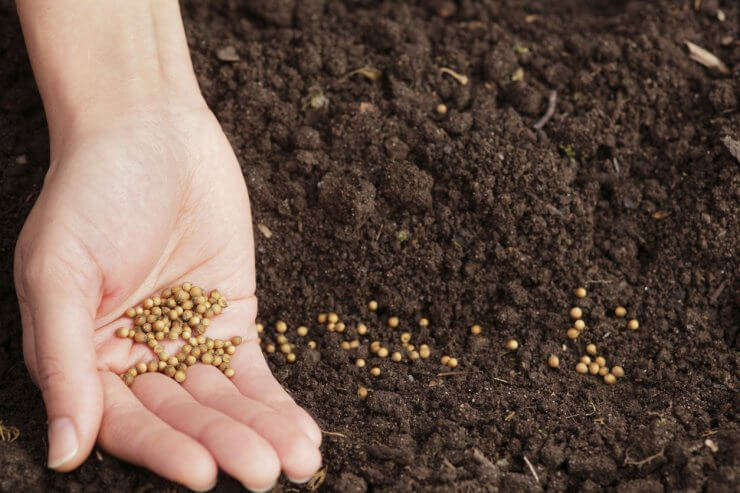
Gardener planting cilantro seeds in soil
No-dig gardener Charles Dowding says multi-sowing seeds is a great way to save time and space in your garden
Tell me, fellow gardener… if you buy a square of onion sprouts at the gardening supply shack, do you plant each little tiny bulb one by one, or do you bunch them? When you plant carrots, do you space your seeds apart, or do you just sprinkle and see what happens? Most gardeners I talk to thin them out, one by one, but master gardener Charles Dowding would disagree, so I wanted to talk about his multi-sowing seeds method, because last year I tried out both!
According to Charles Dowding, you can sow 4-5 seeds in the same place, and not thin them at all. The downside is that your vegetables might end up being smaller, but the benefit is that you can get more from a smaller space. It won’t work for all plants. For example, tomatoes, peppers, cauliflower, those kinds of big bushy plants need a lot of room. But radishes, onions, and carrots are all fair game.
Last year I tried the Charles Dowding multi-sowing seeds method and I’m a believer. For proof, just look at this radish harvest, and I got harvests like this all summer long just from sprinkling seeds all willy nilly in my garden beds. The only problem with this method is having too many veggies to use at once!
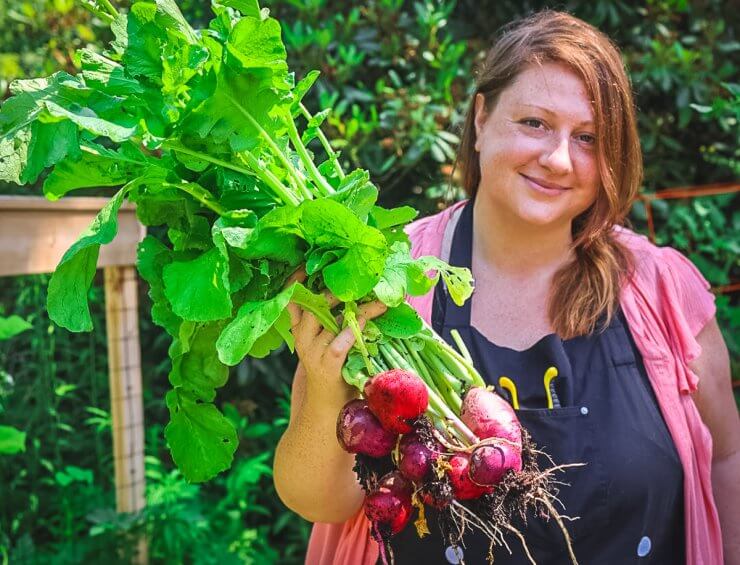
Discover 7 top tips for growing, harvesting, and enjoying tomatoes from your home garden—when you access the FREE guide The Best Way to Grow Tomatoes, right now!
Who is Charles Dowding?
So if we’re going to go and follow some guy’s advice, you probably want to get to know him first, if you don’t already. Charles Dowding is a master gardener and gardening personality who has been vegetable gardening since 1981 and is most famous for his “no dig gardening” methods. He’s an author, writes for gardening publications, and has a YouTube channel.
No dig gardening in a nutshell, is the process of building up, instead of digging down. Your first year, you lay down cardboard or other material on the earth to block out any weeds, and then you add rich compost and manure on top. Each year, you build this soil with more compost and manure by a few inches, and you can use worms to aerate the soil. No additional fertilizer is needed, and the process is organic. Instead of feeding the plants, you end up focusing mostly on improving your soil every year.
The “no dig” portion of the method refers to digging into the flat earth, instead, you are creating a raised garden bed of soil with no box. It’s easy to maintain, and your garden will grow or at least compete with, any other type of garden for less work.
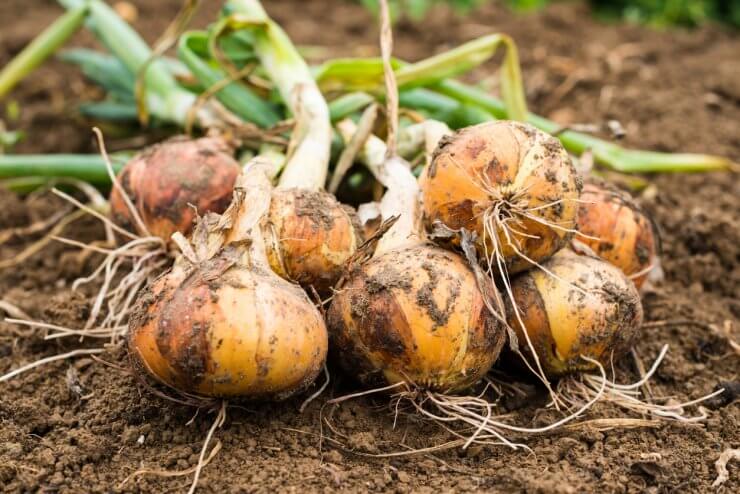
What About the Multi-Sowing Seeds Method?
Many people attribute the multi-sowing seeds approach to Charles Dowding, which is the practice of doing exactly how it sounds – sowing multiple seeds in the same place, which many gardeners do—but without thinning them out. These are the benefits that he sees with this approach:
- Get more plants growing in a smaller area
- Need less compost for more plants
- Save time on sowing and thinning
- A companion planting benefit, because plants of the same type like being planted together.
Dowding warns, ” Do not sow too many root vegetables in a clump, or you will have more leaf in proportion to root, meaning the roots will stay small.”
How Many Seeds Should You Sow in a Clump?
The number of seeds you sow, and how many can grow in a clump are different. Dowding suggests a few extra seeds per hole you plant, just in case not everything germinates. Here are some suggestions on multi-sowing seeds from the master-sower himself:
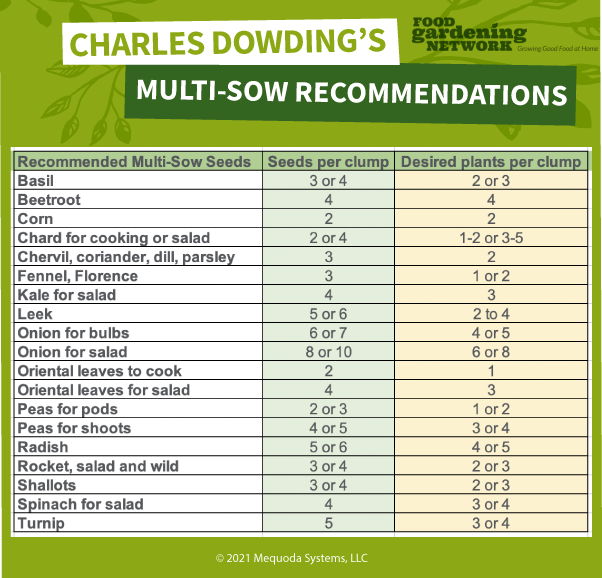
This isn’t an exhaustive list of everything you could multi-sow but it includes plants that work best for multi-sowing, according to Dowding. He says you can multi-sow seeds for just about anything, but you might not get a great crop.
For example, Dowding says you can multi-sow celery, you’ll just get thinner stalks which is fine if you’re just using celery for soups.
French beans are another exception because they already grow and produce so much, there’s little point in multi-sowing. The point of multi-sowing seeds is to save time and space, not necessarily to yield larger crops.
Personally, onions didn’t work for me, their bulbs barely grew larger than an inch, and then they began to rot once they did. I think onions would appreciate more space apart, personally, though I’m willing to try again.
Carrots though, let me tell you, I had carrots coming out of my ears and they grew in all shapes and sizes. I had no complaints!
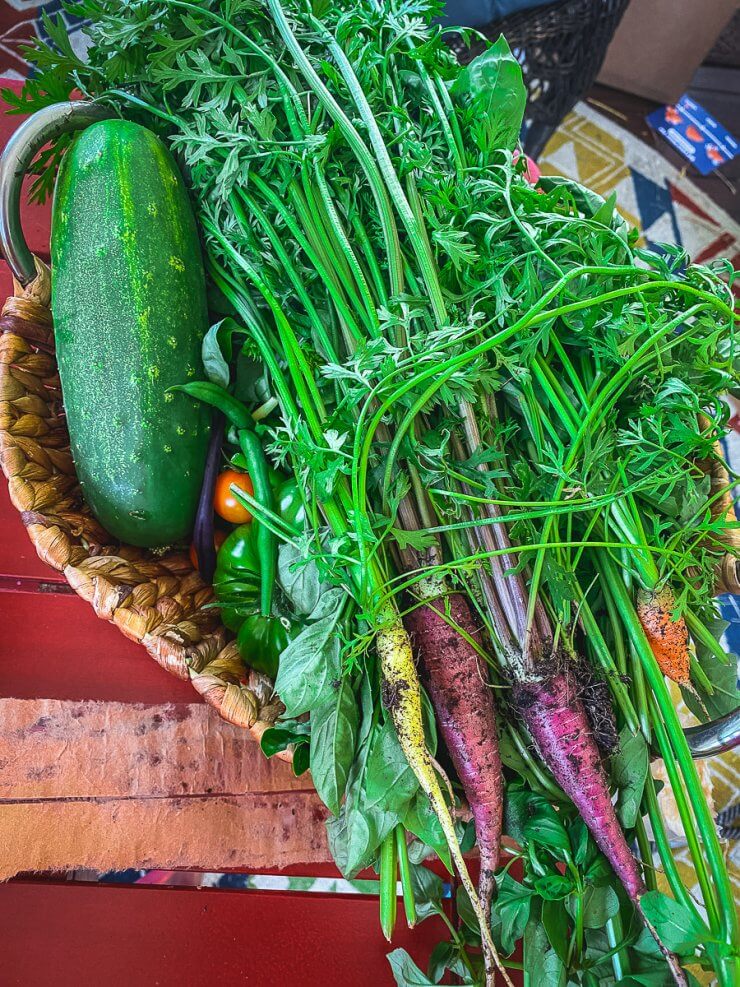
So if you already have one plant that produces well on its own, there’s no need to multi-sow. Another exception is lettuce, which is difficult to harvest outer leaves when multi-sown. On the other hand, rocket salads are easily harvested and can be sown together. To me, I found the root veggies to be prime candidates for this method and I’ll do it again this year!
Dowding offers online courses on his website for more in-depth tutorials on no-dig and multi-sowing worth checking out.
Have you ever tried multi-sowing seeds using this method? What were your results?
Discover 7 top tips for growing, harvesting, and enjoying tomatoes from your home garden—when you access the FREE guide The Best Way to Grow Tomatoes, right now!





I don’t do this method intentionally, but I’m not that good at spacing. Even so, I end up with lots of lettuce and carrots! I get tons of lettuce by the “cut and come again” method! Some of my carrots are small, funky-shaped, they’re not pretty, but mighty good eatin! Yes, I just chow them down. I don’t peel my carrots. I believe there are a lot of nutrients there.
This method is very similar to the “Wide Row” method discussed in Dick Raymond’s book, “Garden Ways Joy of Gardening” just a year earlier, 1981. Tm.
M. Todd Morando, KC, KS
Sorry, folks, just realized Mr. Dowding began his work the same year. Tm.
This is great news. I’ve been meaning to thin my carrots all summer. I had decided to leave them as I have too many projects that need finishing. So we will see how they do. I might do an experiment and leave 1\3 as is, 1/3 slightly thinned and 1/3 thinned to “correct” spacing and see which I’m happiest with.
You mentioned carrots above, but it doesn’t really work (unless maybe you are not peeling your carrots). I space my carrot seeds and get nice big carrots, but my wife just sprinkles. Not only do I have to keep buying carrot seeds (which are not cheap) because she goes through 5x the amount, but when I go to dig up her carrots I end up composting 3/4 of them. It’s really hard to peel a 2-3 inch skinny carrot and get anything useful. Even though it takes me a long time to plant a carrot bed, the yield is significantly higher than the sprinkle method. I recently went out to dig up a bed of my wife’s carrots and I barely had half a bucket, when for that space I should have had a bucket or two. Maybe you just sprinkle better and that’s why it works for you. As a side note, for my beds once the carrots sprout, I go back and fill in any gaps for seeds that didn’t germinate. Same goes for my beet beds, but those seeds are much easier to handle.
You know you can just give carrots a nice scrub and not peel them
The trick with beets I’ve found is to keep the dirt pushed up around the root with about 3 inch spacing (they like company) , get them in early (they do not like heat} and keep them watered!! Those thinning s are like gold in the kitchen. You can plant them in the fall, but growth will be a lot slower.
I have practiced this no dig method kinda willy-nilly, so I appreciate the instructions. My question is, when you speak of “rich compost and manure,” where do I get it? I don’t compost, and I don’t like animal manure because I am vegan and organic. Thanks for a reply.
As an organic vegan gardener composting your food and garden waste is something you really should look into, as you potentially have so few other truly trustworthy sources available to you. You can also collect your neighbours garden waste to compost. Also (possibly not a popular choice) you could always compost your own and your family’s waste using a sawdust toilet (see the Humanure Handbook) ????
I know this is over a year late but here are some options for finding compost- you can often find available compost at universities and colleges that have agriculture in their curriculum, local garden clubs, check your city’s website (esp. if that recycle,) check/leave a note on your co-op bulletin board.
Hope this helps.
Great post. I tried this method with scallions, beets, and radishes. The scallions are amazing. I never harvested the plants but just kept chopping them back, sort of like chives, and they sprouted again. With radishes and beets, Dowding recommends harvesting the largest bulb from a clump and letting them grow. That worked great for radishes @ 4-inch spacings, but my beets struggled. After I harvested golf-ball-sized callings from each clump, I gave it time… and got more tiny golf-ball-sized beets. The final harvests never developed into full-sized beetroots. I’m trying beets again in the fall using 6-inch spacing.
Worked well